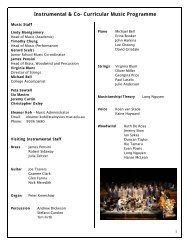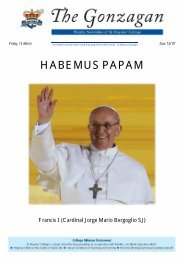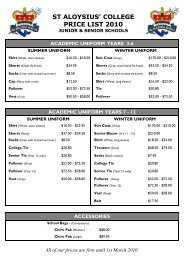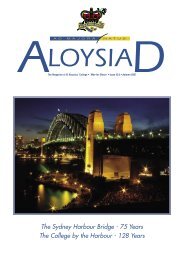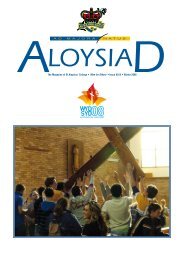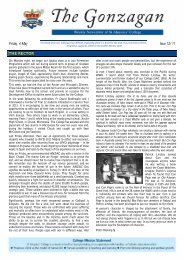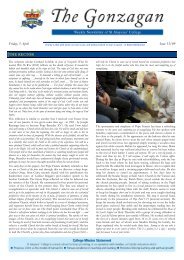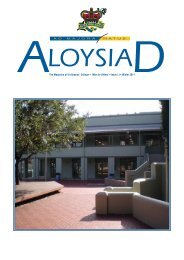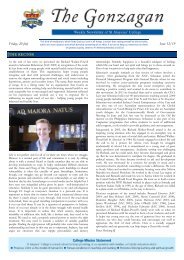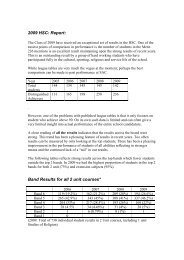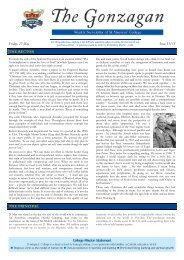Aloysiad 15-12 2006.indd - St Aloysius
Aloysiad 15-12 2006.indd - St Aloysius
Aloysiad 15-12 2006.indd - St Aloysius
You also want an ePaper? Increase the reach of your titles
YUMPU automatically turns print PDFs into web optimized ePapers that Google loves.
from the senior school<br />
remarkable achievement. Jacques McElhone (Year <strong>12</strong>) and<br />
James Johnston (Year <strong>12</strong>) were selected for the Seconds<br />
with Tom Haremza (Year <strong>12</strong>) and Harrison Grace (Year <strong>12</strong>)<br />
occupying places in the Firsts. Harrison went on to Captain<br />
the NSW School’s Debating Team which came second at<br />
the Nationals in Darwin. Special praise and thanks must<br />
go to Harrison for his splendid Captaincy of the Debating<br />
Squad and NSW – quite an achievement!<br />
The boys, of course, thoroughly deserve the above<br />
successes however mention must be made of their excellent<br />
coaching. With ten coaches looking after the Squad, a<br />
rigorous training schedule is now well and truly up and<br />
running. Nik Kirby (SAC 2001) and Aaron Rathmell (SAC<br />
2001) are our head coaches and their work with the<br />
Senior boys has been truly outstanding. The combined<br />
experience of all our coaches means that our boys are<br />
equipping themselves quite soundly with the skills necessary<br />
for an articulate and well reasoned style, they are indeed<br />
privileged to be in such a position.<br />
Sincere thanks also to the many parents who regularly<br />
get out the road maps for some of our more remote<br />
Friday night excursions and of course, for the suppers<br />
that invariably fill and impress, at night’s end! Without<br />
this tireless support, we would not have the outstanding<br />
reputation for hospitality that the College enjoys in the<br />
broader debating community.<br />
A final thank you to the College staff, Messrs. Gould,<br />
Irwin, Turnock and Tzantzaris who without fail put in long<br />
hours every Friday evening, plus the regular mid-week<br />
events with skill, sensitivity and humour. Both the boys and<br />
I are particularly grateful.<br />
Our year has ended well. Yes we have had great<br />
successes, but above all, we have helped to develop a<br />
collection of boys capable of presenting well informed<br />
arguments and realistic appraisals of many of the disturbing<br />
issues that are too often presented in the broader community<br />
with anything but a balanced perspective. Congratulations<br />
boys and many thanks.<br />
Mr Mark Norton<br />
Debating Master<br />
Nambucca Heads Cultural<br />
Immersion and Exchange 2006<br />
Working with the Gumbaynggirr People<br />
During our time in the Nambucca Valley we were<br />
fortunate enough to visit the Muurrbay Language<br />
Centre. This centre is run by a group of Aboriginal<br />
elders from the area. The Muurrbay Language Centre was<br />
set up too teach young people out Aboriginal heritage,<br />
language and art and we visited the centre twice during<br />
the two weeks.<br />
During our first visit to the centre, we greeted Aunty<br />
Shirley, who is the aboriginal elder responsible for organising<br />
our visits to the centre, among other things. The elders had<br />
<strong>St</strong> <strong>Aloysius</strong>’ College<br />
A Jesuit School for Boys _ Founded 1879<br />
Left to right: Nick Plummer, Luke Fussell, Brendan Lim, David Prosser<br />
and Will Hart<br />
prepared a medley of sings for us. Some songs were sung<br />
were purely aboriginal but some were of European or white<br />
Australian origin, that had been translated into the Goori<br />
language. These were songs like; Twinkle, twinkle little star,<br />
Mary had a little lamb and Give me a home among the<br />
Gum trees, an Australian classic.<br />
The Choir consisted of singers, guitarist, the clapping<br />
sticks and a DJ. After the initial performance we had a<br />
chance to talk with the elders and have some lunch. From<br />
speaking to the elders we heard many stories from the<br />
Nambucca area, including the story of how that tribe came<br />
into existence. Many of the elders were interested in us and<br />
a lot of out time was spent describing the reason that we<br />
were here; “an exchange and immersion”, were we came<br />
from and what AFL team we supported; a groan echoed<br />
around the room as a voiced that I was a Sydney Swans<br />
supporter.<br />
The second time we visited the centre we were lucky<br />
enough participate in some Aboriginal art lessons, from one<br />
of the elders. The first painting we did involved a process<br />
of drawing charcoal lines and painting within them. This<br />
method was described to us as, “a form of meditation” and<br />
the experience was very relaxing. The process of letting<br />
the charcoal lines go were your hand put them and then<br />
following the line with a paint, dragging the charcoal away<br />
from the line you made, was is a sense, calming, it seemed<br />
to focus and relax you.<br />
At lunchtime one of the elders taught us how to cook an<br />
aboriginal style of bread. The way of making this bread<br />
reflects aboriginality by being so natural. After the dough<br />
was made; a mixture of flour, self raising flour, powdered<br />
milk and water, it was left to settle for a short while, then<br />
cut up and fried. We ate it hot, with butter and jam. But we<br />
could only manage about four pieces as it was so filling.<br />
Later that day we painted a huge canvas, about one<br />
meter high, we divided it into ten sections, that we could<br />
paint ourselves. There was a section for the four of us, our<br />
two teachers and four elders. Each section told a little story,<br />
a l o y s i a d / p a g e 2 0



